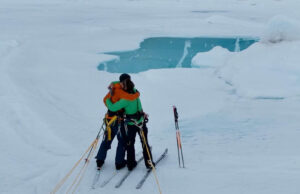“I don’t want petty self-expression…I want the rhythm of eternity,” Rockwell Kent once said about his life. And so he lived.
Kent expressed himself in a profoundly multidimensional manner. Not only famed as an artist, Kent was an explorer, survivalist, architect, leader, and entrepreneur. On his death, The New York Times wrote: “He is so multiple a person as to be multifarious.”
Adventure and art
Between 1920 and 1930 Kent wrote three adventure books: N by E, Wilderness, and Voyaging Southward from the Strait of Magellan. His artistic mindset portrayed his voyages in unusual and creative ways. More than adventure, they are also portraits of the psyche, and of humanity.
Kent’s voyages shaped his art and vice versa. Authentic first-hand experiences reinforced new creative avenues. Many of his paintings and drawings became icons that continue to inspire artists and explorers. I believe their power lies in the feeling and presence of the Arctic. Kent captures the mood of the landscape, lit by the polar light, extraordinarily faithfully. Artists such as Fyodor Konyukhov have continued Kent’s style. “Rockwell Kent inspired my life,” Konyukhov told me.
Kent expanded his interest, from purely artistic, to exploration, survivalism, and sailing. This call to adventure in turn initiated his quest for manhood. In his memoirs, he wrote of the strong arms and physical presence of the fishermen he saw while painting on the shore of the Dublin Pond. He wrote that he would like to earn some of this physical rooting himself.
So his journey began. It was built on self-made houses, dance floors, and boats. He sailed as far north as Alaska and Greenland, and as far south as the Strait of Magellan. With almost every journey, he built a new house.
His “cursed libido”
Greenlandic society was a utopian model of his socialist ideals. It fit his political beliefs, his artistic spirit, and what he called his “cursed libido.” Raised in a traditional society, he reflected upon his experience of indigenous openness and physical intimacy: “What we stigmatize as fornication and adultery is for them a natural pastime, spiced by being slightly wicked.”
He called Greenlanders, “the most friendly, loving, kind, and filthy, dirty people in the world,” and he enjoyed living as a Greenlander as he defined it. Kent doesn’t elaborate, but I saw more tolerance for LGBT minorities in Greenland 13 years ago than I have seen anywhere else in the world. Tolerance and openness in those small towns seem deep-rooted.
According to his journal, Kent’s promiscuity in Greenland was only surpassed by German actress Leni Riefenstahl. Riefenstahl’s arrival in Greenland coincided with the celebration of Kent’s fiftieth birthday, for which he built a dance floor. According to Kent, Riefenstahl had so many visitors to her tent that the Greenlanders called her “the mattress”.
Work and play
During Kent’s three visits between 1929 and 1935, a splendid collection of art emerged. One of the most notable titles was Salamina, which depicted his time with a woman of that name, along with other local women.
Though many polar explorers cohabited with Inuit women, he was the only one who dared go into detail. To an American audience, the book was odd, but the writing never violated or trespassed the boundaries of Greenlanders’ sense of decency. That was the only behavioral savoir-vivre that Kent cared to obey.
In Greenland, he worked for about 14 hours each day. He built houses, created art, bred dogs, hunted, and contributed to the life of the small settlement of Igdlorssuit. The Greenlanders adored him. On his departure, they gathered on the shore and sang a farewell hymn. He responded: “Farewell Igdlorssuit, as though to life.”
Persecution in the United States
As an entrepreneur back in New York state, Kent used Nordic names for his enterprises. So he named his dairy farm Aasgard, the home of the Nordic Gods. He spent most of his time there, running the farm and creating art. He hosted meetings for the intellectual elite in the evenings but rose early each morning to start work at 6 am.
Politics and socialism remained important to Kent and he found ways to work his beliefs into his work. The Canadian-Icelandic explorer Vilhjalmur Stefanson noticed that Kent had left a cryptic message in Inuktitut on a mural commissioned by the United States government. It called for the Puerto Ricans to change chiefs and free themselves.
For this, and many other socialist actions and affiliations, he was often persecuted by the American government. It deemed his books Communist and subversive. If found, they burnt his books. This persecution dented his popularity and led to financial problems.
An imitator of himself
Despite these hardships, he never stopped creating. Toward the end of his life, he tried to start again under another name, only to be labeled an imitator of Rockwell Kent. “Being an imitator, even of oneself, is despicable,” he responded.
His artistic career culminated with a major exhibition in Moscow. It was the first solo show by an American artist in the Soviet Union and Kent’s final exhibition. This is where his artwork remains. He left a legacy of hundreds of works, from drawings and paintings to murals and sculptures. However, he is best remembered for his early illustrations of Moby Dick.
I see a great deal of William Blake in Kent’s art. The same highly charged body shapes, with an aura of mysticism, though Kent topped it off with elements of socialist realism on many occasions. Both Blake and Kent sought to recover their physicality, and I think this quest defined them as much as their art.
Before his death, Kent said: “I got all I could get out of life. All I want? No…I want it all. Don’t you?”






